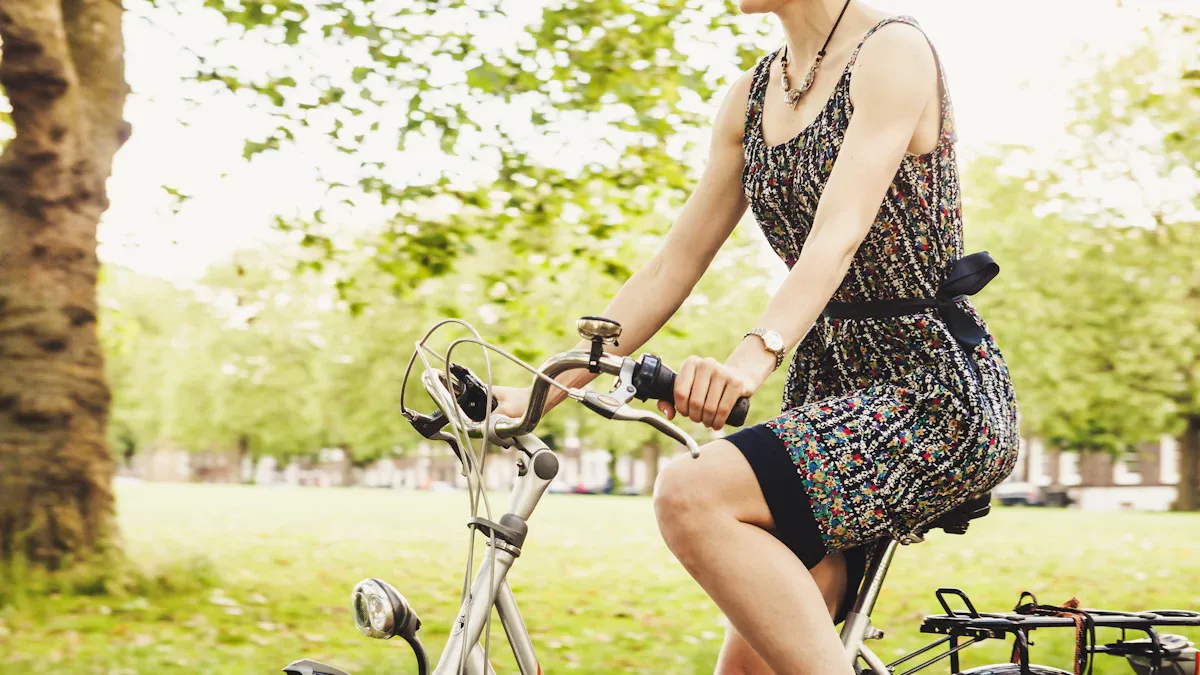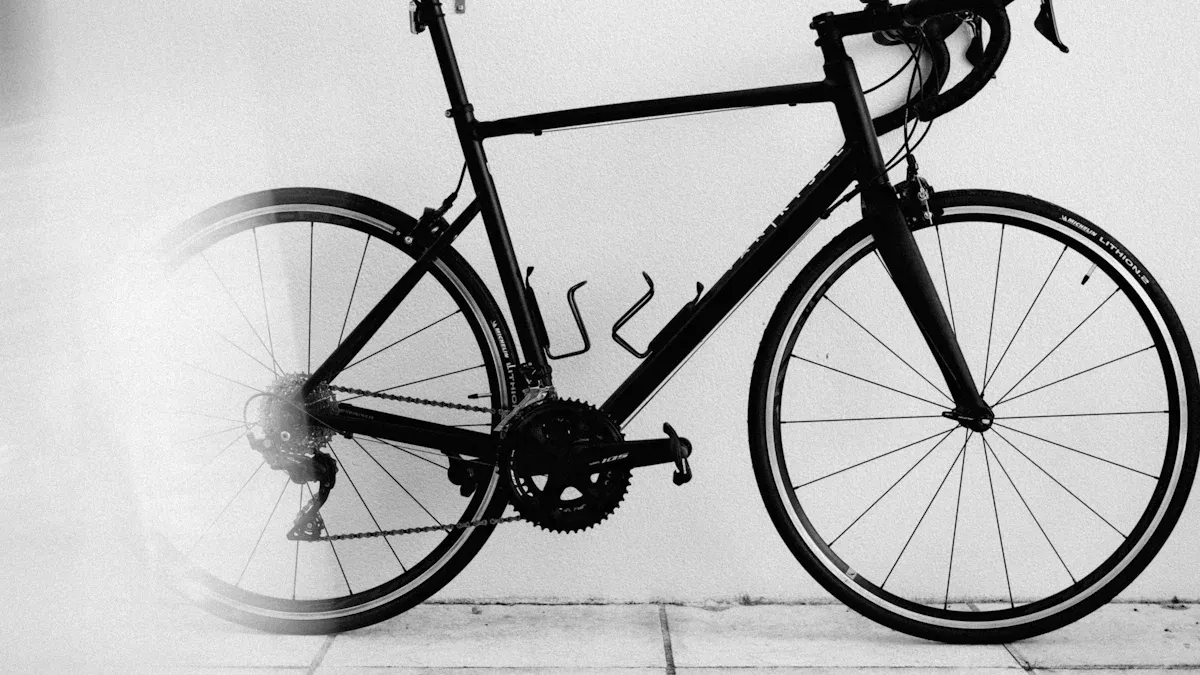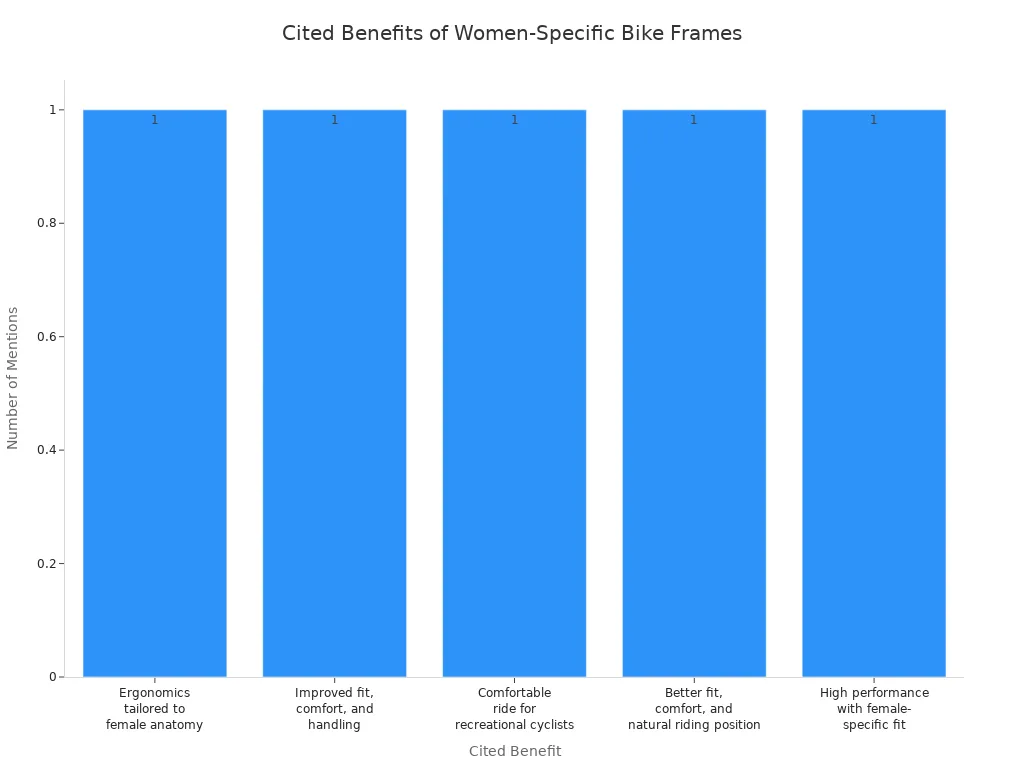
You will notice key differences between women’s bikes and men’s bikes, especially in their shape, fit, and comfort. A womens bike frame often features a shorter top tube and a lower standover height, designed to accommodate a shorter torso and longer legs. Typically, a womens bike frame includes a step-through design, making it easier to mount the bike, which is especially helpful if you wear skirts or dresses.
Anatomical Difference | Typical Male | Typical Female | Bike Frame Design Impact |
|---|---|---|---|
Torso Length | Longer | Shorter | Womens bike frames have a shorter top tube for better reach |
Hip Width | Narrower | Wider | Womens bike frames may have wider saddles |
These design elements make womens bike frames more comfortable for many riders. The frame style differences are influenced by both anatomy and cultural factors. Understanding these main differences will help you choose the right womens bike frame for your needs.
Key Takeaways
Women’s bike frames have shorter top tubes. They also have lower standover heights. This fits people with shorter torsos and longer legs. It makes getting on the bike easier. It also makes riding more comfortable.
The geometry of women’s bikes is different. They have a shorter reach and stack height. This helps riders sit up straight. It stops pain in the back and shoulders on long rides.
Women’s bikes have wider saddles. They also have narrower handlebars. These match the shape of a woman’s body. This makes riding more comfortable and easier to control.
Some women’s bikes have step-through or low-step frames. These frames are easy to get on and off. They can be a little heavier and less stiff. They are good for city and casual rides.
Picking the right bike is about fit and comfort. It is not just about if it is for men or women. Try different frames and change parts like saddles and handlebars. This can help you find the best bike for you.
Womens Bike Frame Geometry

Stack Height and Reach
When you look at a womens bike frame, you will notice that the stack height and reach are different from those on men’s bikes. Stack height is the vertical distance from the bottom bracket to the top of the head tube. Reach is the horizontal distance from the bottom bracket to the head tube. These measurements shape how you sit and control the bike.
Women’s bicycles usually have a shorter stack height and a shorter reach. This design matches the average height and leg length differences between men and women. Most women have longer legs and shorter torsos compared to men of the same height. Because of this, a women’s bike frame often uses a shorter effective top tube and a longer head tube. You will find it easier to reach the handlebars, which helps you ride comfortably and with better control.
Bike brands design women’s bikes with these differences in mind. They want you to feel confident and balanced. A shorter reach means you do not have to stretch forward as much. This helps you avoid back and shoulder strain. In both road and mountain bikes, a women’s bike frame will have a shorter top tube and a more upright position. You can ride longer without discomfort.
Tip: If you feel stretched out or cramped on your bike, check the stack height and reach. The right frame geometry can make a big difference in your comfort and performance.
Standover and Top Tube
Standover height is the distance from the ground to the top of the top tube. This measurement matters when you get on or off your bike. Women’s bicycles often have a lower standover height than men’s bikes. This is because a women’s bike frame uses a sloping or dropped top tube. You can swing your leg over the bike more easily, which is helpful if you wear skirts or have limited mobility.
The low-step frame, also called a step-through or slanted top tube, is common in women’s bikes. This frame design and geometry makes mounting and dismounting simple. You do not need to lift your leg high. This feature is great for city riding, commuting, or anyone who wants a more accessible bike.
Here is a table comparing slanted and traditional top tubes:
Aspect | Slanted (Low-Step Frame) | Traditional (Horizontal) Top Tube |
|---|---|---|
Rider Accessibility | Easier mounting/dismounting, ideal for all | Requires lifting leg over frame |
Frame Strength | More flex, less stiffness | Higher stiffness, more strength |
Frame Weight | Heavier due to extra support | Lighter |
Riding Position | Upright, comfortable | Aggressive, performance-oriented |
Use Case | Urban, casual, inclusive | Sport, off-road, racing |
Stability | Stable at moderate speeds | Better at high speeds |
A low-step frame does have some trade-offs. The slanted top tube can reduce frame stiffness, so the bike may flex more during hard riding. To keep the frame strong, designers add extra material, which can make the bike a bit heavier. Still, for most riders, the benefits of easy access and comfort outweigh these drawbacks.
Bike brands justify these choices by looking at real rider needs. They know that women’s bikes must fit a wide range of body types. Some brands, like Liv, design women’s bicycles from the ground up, adjusting every part of the frame design and geometry. Others, like Trek and Specialized, use unisex frames but change the contact points and offer more sizes. The goal is always to help you find a bike that feels right.
Note: Not every woman needs a women’s bike frame. Some women fit better on standard frames. Always try different bikes to see what works best for your body.
The frame geometry of women’s bikes reflects both science and rider feedback. You get a bike that matches your proportions, supports your riding style, and helps you enjoy every ride.
Differences Between Men and Women Bikes
Frame Structure
Men’s bikes and women’s bikes are built differently. The frame shape fits the average body shape for each group. Women’s bikes have a shorter top tube. They often use a sloping or step-through frame. This helps if you have a shorter torso and longer legs. Men’s bikes have a longer top tube and a straight crossbar. This fits people with longer torsos and shorter legs.
Both types use the same materials, like aluminum or steel. Carbon fiber is also common. The real difference is in the frame shape and size, not what it is made from. Women’s bikes usually have narrower handlebars. The saddles are wider to match hip shape. Brake levers are closer to the handlebars. This helps if your hands are smaller.
Here is a table that shows how men’s and women’s bikes are different:
Structural Aspect | Women’s Bikes | Men’s Bikes |
|---|---|---|
Top Tube | Shorter, sloping or step-through | Longer, straight crossbar |
Handlebar Width | Narrower | Wider |
Saddle | Wider, more padded | Narrower, firmer |
Brake Levers | Closer to handlebars | Standard distance |
Frame Size | Smaller, lower standover height | Larger, higher standover height |
Tip: You can change parts like the saddle or handlebars. This helps you get a better fit on any bike.
Riding Position
How you sit on the bike is also different. Women’s bikes let you sit more upright. This makes long rides more comfortable. The short top tube and high handlebars help you avoid stretching too far. This means less pain in your back, neck, and shoulders.
Men’s bikes make you lean forward more. This is good for speed and power. But it can feel uncomfortable if the bike does not fit you. The seat tube angle is steeper on men’s bikes. This pushes you forward and helps you pedal fast. On women’s bikes, the seat tube angle is not as steep. This lets you sit up straighter and ride in a relaxed way.
If your bike does not fit your body, you might feel pain or numbness. Your hands, back, or neck could hurt. That is why it is important to pick a bike that fits you well. The differences in men’s and women’s bikes help you find a bike that feels right and keeps you safe.
Women’s Bicycles: Components
Handlebars and Saddles
Women’s bicycles have handlebars and saddles that are not the same as men’s bikes. These changes help you ride with more comfort and safety. Most women’s bikes use handlebars that are more narrow, starting at about 380 mm. This fits people with smaller shoulders and helps you steer better. The handlebars are often smaller and sometimes flat. This lets you sit up straighter on the bike.
The saddle is also very important. Women’s bikes use saddles that are wider and shorter. This supports wider sit bones and spreads your weight out. It helps stop pressure from building up. Many new saddles have special padding. There is firmer foam under your sit bones and softer foam where your soft tissue touches. Some brands use pressure mapping to put padding in the best spots. This helps you avoid pain and numbness, even if you ride for a long time.
Feature | Women’s Bikes | Men’s Bikes |
|---|---|---|
Handlebar Width | Narrower, starting from about 380 mm | Wider, around 400 mm |
Handlebar Shape | Smaller, often flat for upright position | Wider, for longer reach |
Saddle Width | Wider and shorter | Narrower and longer |
Saddle Shape | Curved, with channels for pressure relief | Narrower, designed for speed |
Tip: You can measure your sit bones at home. Sit on a piece of cardboard and mark where your bones press down. Pick a saddle that is at least 1 cm wider than your sit bone marks for the best comfort.
Brake Levers and Stems
Brake levers and stems on women’s bikes are made to fit better. Many women’s bikes use shorter stems. This makes it easier to reach the handlebars, especially if your torso is short. Shorter stems help you sit up and stop you from stretching too far.
Brake levers on women’s bikes often have a shorter reach. This means you can grab the brakes easily, even if your hands are small. Some brands add bolts to the levers so you can move them closer to the handlebars. If you need more change, you can add rubber pieces or spacers. These changes help you control the bike and stop safely.
Women’s bikes often have:
Shorter stems for easier reach
Brake levers with shorter reach for small hands
If you have trouble reaching your brake levers, check if your bike lets you adjust them. You can usually fix this at home with a simple tool. This small change can help you feel safer and more comfortable.
Fit and Comfort

Suspension and Gearing
When you look for a new bike, you might wonder if women’s bikes have special suspension or gearing. The truth is, most differences in gearing come from personal needs, not gender. Riders choose gears based on strength, how fast they like to pedal, the type of terrain, and whether they ride for fun or competition. Some women prefer lower gears because they might have less muscle mass, but this is not always true. Many women use the same gearing as men, and even professional cyclists have different preferences.
Gearing choices depend on:
Your strength and how you like to pedal
The hills or flat roads you ride on
Whether you want to ride fast or just enjoy the scenery
Your own comfort and riding style
Bike brands do not make big changes to gearing just for women. Instead, they focus on frame geometry, saddle shape, and handlebar size. You should pick gears that feel right for you. The right gearing helps you ride longer and with less effort. Suspension also works the same way. Some women’s bicycles have softer suspension, but most important is that the suspension matches your weight and riding style. You can adjust many suspension systems to fit your needs.
Tip: Try different gear setups and suspension settings. Find what makes your ride smooth and easy to control.
Choosing the Right Bike
You might think you need a women’s bike just because of your gender. This is a common mistake. The best bike for you is the one that fits your body and feels comfortable. Do not rely only on labels like “women’s-specific.” These labels can mean different things for each brand. Some brands only change the paint or a few parts and call it a women’s bike.
Here are some things to remember when choosing a bike:
Do not assume you need a women’s bike because of your gender.
Always check the frame size and try different bikes.
Pay attention to how the bike feels when you ride it.
Test both women’s bikes and unisex models.
Adjust the saddle, handlebars, and other parts for the best control and comfort.
Ask a professional for a bike fit if you are unsure.
Professional bike fitters know that women often have wider hips and more sensitive pelvic areas. You might need a wider saddle or special padding to avoid pain. Fitters also look at your knee angle, leg length, and shoulder width. They help you find the right position to avoid injuries and ride longer. Sometimes, women need a shorter top tube or a different handlebar shape. These changes help you sit in a natural position and keep your hands, back, and neck comfortable.
When you pick a bike, focus on how it fits your body. Inseam length is very important for choosing the right frame size. This measurement helps you find a bike with the right standover height and saddle height. Use size charts as a starting point, but always test ride if you can. Your riding style also matters. Road bikes might need a smaller frame for speed, while mountain bikes need a size that lets you move easily.
Note: The best bike is the one that fits you, not the one with a certain label. You can always change parts like the saddle or handlebars to make any bike fit better.
Many women find that unisex or men’s bikes fit them better, depending on their body shape. Do not limit your choices. Try different models and ask for help if you need it. The right bike size and fit will help you ride with more control and comfort. Remember, you can ride any bike if it fits you well.
You can see that women’s bike frames have some special features. They often have shorter top tubes. The handlebars are more narrow. The saddles are wider to fit many women’s bodies. These changes help you ride longer and feel better.
Women-specific bikes use compact geometry and ergonomic parts. This helps you get less tired and have more control.
Many people feel best by changing the saddle or handlebars. You do not always need a women’s frame for comfort.

Always try different bikes and ask an expert for help. The best bike is the one that fits your body and feels good, no matter what it is called.
FAQ
What if a women’s bike frame feels too small for me?
You can try a larger size or look at unisex frames. Every body is different. Test different bikes to find one that fits you best. Comfort matters more than the label on the bike.
Can men ride women’s bikes?
Yes, you can ride any bike that fits your body. Some men prefer women’s frames for the upright position or easy step-through design. Fit and comfort always come first.
Do women’s bikes cost more than men’s bikes?
Prices are usually similar. Cost depends on the brand, materials, and features. You should compare models and choose the one that matches your needs and budget.
How do I know if my bike fits me?
Stand over the frame. You should have space between you and the top tube. When you sit, your knees should bend slightly at the bottom of each pedal stroke. If you feel pain or numbness, adjust the saddle or handlebars.
Can I change parts on my bike for a better fit?
Yes, you can swap out:
Saddles
Handlebars
Stems
Brake levers
You can make any bike more comfortable by changing these parts. Ask a bike shop for help if you need it.
See Also
Differences Between Triathlon And Time Trial Bike Frames
Key Differences Between Fat And Mountain Bike Frames
Why Titanium Bike Frames Stand Out Among Others
